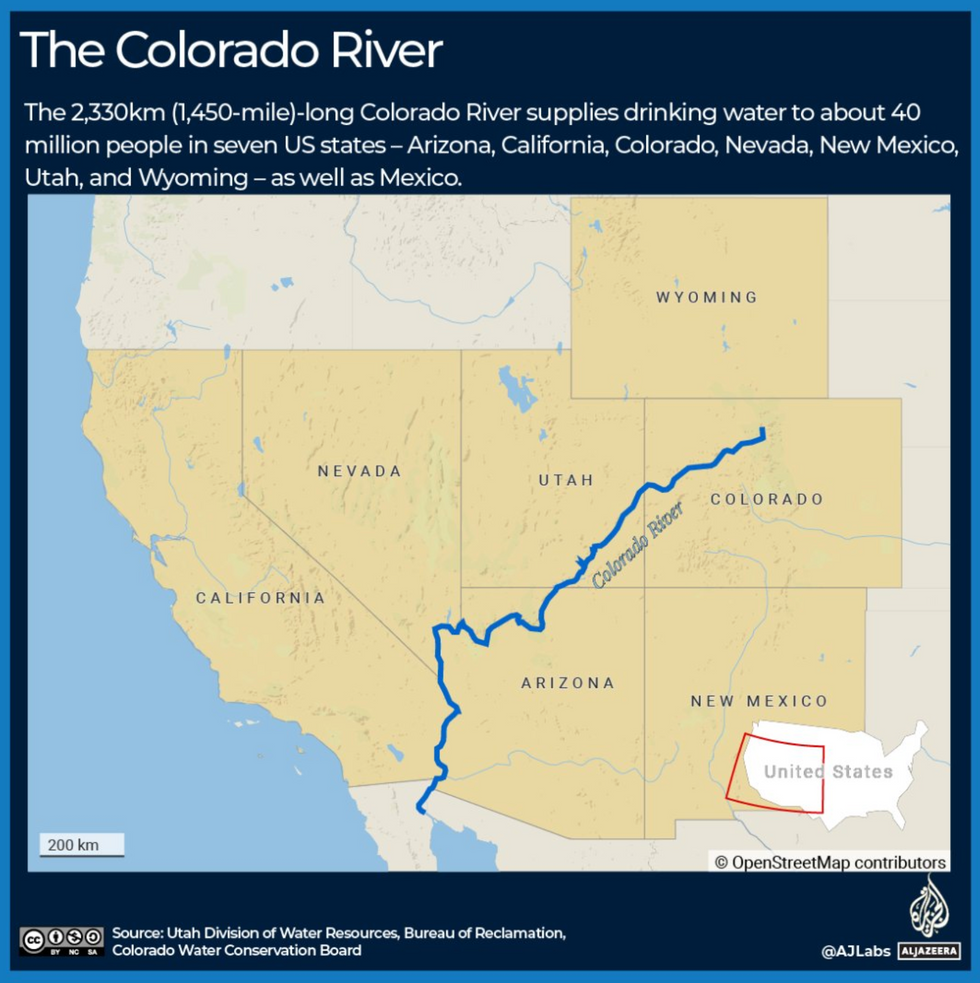"There are 40 million people, seven states, and 30 tribal nations who rely on the Colorado River Basin for basic services such as drinking water and electricity," U.S. Interior Secretary Deb Haaland said in a statement. "Today's announcement is a testament to the Biden-Harris administration's commitment to working with states, tribes, and communities throughout the West to find consensus solutions in the face of climate change and sustained drought."
"The agreed-to cuts are significantly less than what federal scientists and officials had said were necessary to stabilize the river system on which tens of millions in the Southwest rely."
Last August, amid extreme drought driven by the climate emergency and warnings of a possible "catastrophic collapse" of the Colorado River, the U.S. Interior Department announced the first-ever tier 2 shortage for the waterway, triggering water-use cuts in Arizona, Nevada, and the country of Mexico for 2023.
U.S. Bureau of Reclamation Commissioner Camille Calimlim Touton called the agreement "an important step forward towards our shared goal of forging a sustainable path for the basin that millions of people call home."
Arizona Gov. Katie Hobbs, a Democrat, hailed the "partnership with our fellow Basin states and historic investment in drought funding," while asserting that "we now have a path forward to build our reservoirs up in the near-term."
"From here, our work must continue to take action and address the long-term issues of climate change and overallocation to ensure we have a sustainable Colorado River for all who rely upon it," Hobbs added.
Luke Runyon, president of the Society of Environmental Journalists, noted on Twitter that "the agreed-to cuts are significantly less than what federal scientists and officials had said were necessary to stabilize the river system on which tens of millions in the Southwest rely."
John Entsminger, general manager of the Southern Nevada Water Authority, toldE&E News that "the plan set forth by the Lower Basin states is not a panacea for the river, but rather a consensus solution that will help manage near-term water demands while serving as a bridge to negotiate the post-2026 operating criteria."
"The Colorado River Basin has a warmer and drier future ahead and reducing water use, increasing water efficiency, and maximizing water recycling and reuse is paramount to a sustainable future for the 40 million people that depend upon this critical water supply," he added.
As Common Dreams reported last month, advocacy groups including Food & Water Watch also criticized proposed deals between the administration and states for failing to address the overexploitation of water resources by corporate agriculture and fossil fuel companies.
While unusually heavy snowfall and subsequent spring meltwater have helped temporarily avert what experts warned last year could be a "doomsday scenario" for the Colorado River Basin in 2023, the vital waterway remains in danger of running too low to provide enough water for all who rely upon it.
The Colorado River historically ran about 1,450 miles from its headwaters high in the Rocky Mountains of northern Colorado into Utah, through the Grand Canyon in Arizona, and then along Nevada and California's southeastern borders before flowing into the northernmost tip of the Gulf of California in Mexico.

The river—which is an oasis in the unforgiving desert that surrounds it for much of its course—long sustained Indigenous peoples both before and after the genocidal colonization of the Southwest, and since the U.S. conquered the region from Mexico it has been a lifeline for American settlers and cities as well as Native tribes.
Western states began dividing the river's water between them around a century ago, and throughout the 20th century, massive dams and channels diverted water hundreds of miles away to sprawling, thirsty farms on previously desert lands and to rapidly expanding cities like Los Angeles, Phoenix, San Diego, and Las Vegas.
Under the Colorado River Compact, states sidestepped Indigenous tribes and agreed to annual water allocations that they must use in full or face usage-based cuts the following year. This "use it or lose it" system has created what critics call "perverse" incentives for farmers to grow water-intensive crops in the desert.
Today, around three-quarters of the river's flow is siphoned off to irrigate more than five million acres of farmland, according to the U.S. Bureau of Reclamation. Hydroelectric plants along the Colorado also generate more than 12 billion kilowatt hours of electricity annually.
The river has been running especially low in recent decades as worsening droughts driven by the climate emergency have gripped the Southwest and as the population of the nation's driest region explodes. The Colorado no longer empties into the sea, and models predict that by the year 2100 its flow could be further reduced by more than half.
"The only way to solve the long-term shortage on the Colorado River is to take a lot less water out of the system," environmental and resource economist Nick Hagerty stressed in reaction to Monday's announcement. "Which necessarily means permanent reductions in crops grown. That's where the focus needs to be."



